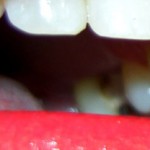Let’s keep this brief. No. Never put a double space after a period. Well, almost never.
Let’s back up. If you were born before the Reagan administration, you may have learned typing on a typewriter (i.e., not a computer). You were taught to put two spaces after a period. And that was correct. A typewriter has only one font, and that font is a monospaced font. That means each character takes up the same horizontal width. So if you typed a series of lines, the characters would line up both horizontally and vertically. This is great if you’re creating a word search.
In order to make the end of a sentence be visually obvious, two spaces were placed after the period. In a monospaced font, a period takes up the same amount of space as a W and is placed within the middle of that space. So at the end of a sentence, that period already has a large amount of white space to its left. And when the period appears after a thin character, such as a lower-case L, the space between the two becomes quite large. And when only one space is placed after a period, the end of sentence becomes less noticeable.
Therefore, many of us were taught to place a second space after a period. Some say even in a monospaced font this is unnecessary. I think those people have a point in that the second space creates an awkward white space that is overkill. But in the balance between readability and design, I’d err on the side of readability in this case.
Enter modern-day computers and typography. Enter kerning. What is kerning? Kerning refers to the spacing between characters, and any half-decent proportional (i.e., not monospaced) font has custom kerning designed into it. Most word processing and design software will allow you to tighten or loosen the kerning. Sometimes you want to do this for design purposes, sometimes you may do this because you need to squeeze your text into a small area, and some fonts just look better with a tiny kerning adjustment (this is often true at larger sizes). But the point is that today’s fonts include characters designed to take up the amount of horizontal space that is the most visually appealing. This includes the period. It is nestled nicely beside the charcter it follows. No need for an additional space afterwards—one is enough.
Looking into the world of website development, we see that HTML paragraph tags don’t even allow for double spaces. If you enter two (or twenty) spaces side by side within a basic paragraph tag, they will be rendered as one space. Sure, you can simulate a double space by adding a non-breaking space character beside a normal space. And many people (and software programs) do just that. But those people are going out of their way to create bad design.
And that’s what it comes down to—design and readability. I worked for a publishing company as a typesetter in the late nineties. There I worked on technical publications that were gone over with a fine-tooth comb—multiple times. Kerning was evaluated on a character-by-character basis. If it was discovered that a font we used consistently placed too much space between the letter O and C, the kerning within the font was updated (using Fontographer, a once-great software package). It’s not so much a matter of whether you’re using one or two spaces, but making sure that the amount of space after a period is visually appealing and conducive to readability.
The fact is, while monospace fonts have their place, they are normally less readable than proportional fonts. Monospace fonts can still be found on your computer today. The most famous is Courier. Should you include two spaces after periods when using Courier? It’s left up to your preference (or your professor’s).




I like two spaces. And you can’t make me stop doing it. (Like that t just did) Because sometimes the period blends in with the last letter and so you need a visual identifier.
There are some fonts that simply don’t include enough space after the period. For example with Myriad I often end up including two spaces after the period.
Um… Your conclusion to (almost) never use two spaces is contrary to your reasoning. Spaces have kerning values too, so a decent font should handle two spaces after a sentence ending period appropriately. (And, as you point out, some relatively dumb renderers like web-browsers and html just eat extra spaces.)
However, by using a single space you lose the difference between a sentence ending period and an abbreviation period. You personally may not think they should be different, but that is a matter of opinion… And using a single space makes it impossible for someone who disagrees with you to render/typeset the text in a way they find more readable or just appealing.
Just use two spaces at the end of a sentence in conjunction with a decent font and/or typesetting program or renderer. Everyone can be happy.
Everything on this site is a matter of opinion. That’s the fun of design. I enjoyed your comment. And I would agree with your opinion if fonts actually did “handle two spaces after a sentence ending period appropriately.” I’m sure there are certain fonts that do this. But with the vast majority of fonts, you end up with an awkwardly-large amount of space at the end of a sentence. And it’s always good to consider the context. If you’re typesetting something that includes a lot of abbreviations, the method you describe makes sense.
Thanks, I just learned a new word!
I thought you said this was going to be brief.
Well, the first paragraph was brief. After that things went downhill :)
I don’t know how I got here but I am on my third um, article blog, and enjoying it all. It would be very difficult for me at this point to stop double spacing but I am thinking about it. Born in 1982 so learned to type on a computer in a “word processor” (what a weird term) but double-space how we were taught in the 90s. That or my teacher just didn’t fully understand the concept.
It’s a difficult rule to unlearn!
As I read your text I notice that the amount of space after a comma appears visually the same as the amount of space after a period and it looks narrower than the space between two words. The whole thing looks like one enormous run-on sentence. Did you type this in a monospaced font? I don’t think so, because your periods are so close to the final letter of a sentence and take up much less space than say a W. There is no additional space after the period. If there were, there would be lll.lll.lll, and http://www.www.www would have different looking spacing between the letters and the periods.
In the end, we write for others eyes, not for our hands or our own design preferences. The goal is to differentiate the end of a sentence from the middle. Look at how tiny these, commas, are. Look at how tiny. these. periods. are. There isn’t much difference, the space actually looks smaller after the period to me! The fact that so many fonts exist today make it impractical to assess each font to decide whether or not to single or double space at the end of a sentence is needed to create that space. #twospacesforlife
Thanks for the detailed reply! I don’t remember ever having problems confusing commas with periods. Even when the font is small, the initial cap starting the sentence after the period makes it immediately clear, along with the grammar of the sentence. Also this is a blog about design, and in the design world you always assess each font every time. For non-designers, not as big a deal—to each their own!